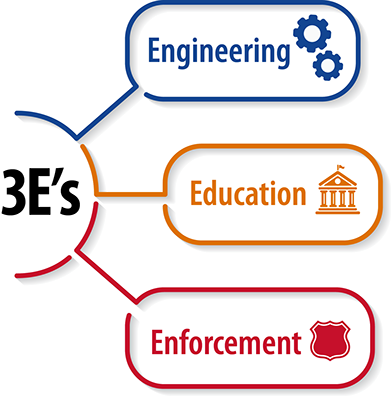
VOLUME 5, ISSUE 1
MENU

Active Travel Doesn’t Have to Mean Dangerous Travel:
TTI Helps TxDOT Improve
Pedestrian, Bicyclist Safety
What comes to mind when someone says traffic safety to you? A car crash, maybe involving alcohol or a controlled substance? A head-on collision at night caused by sleepy drivers? Or maybe your first thought involves a semi-truck losing control and overturning, its trailer load spilling across the highway.
You might not think of pedestrian or bicycle safety right off the bat. But the fact is, nearly 700 walkers and cyclists lost their lives in Texas traffic incidents in 2018. That’s nearly 20 percent of all traffic fatalities recorded that year.
The Texas Department of Transportation (TxDOT) funds specific safety projects through its federally funded Texas Traffic Safety Program, part of its stated agency goal to promote safety and meet the objectives of the Texas Strategic Highway Safety Plan. One of the projects, co-led by Texas A&M Transportation Institute (TTI) Associate Transportation Researcher Neal Johnson and TTI Assistant Research Scientist Jon Graber, aims to decrease pedestrian and bicyclist injuries and fatalities by training law enforcement on pedestrian and bicycle laws.
The project, Law Enforcement Training on Pedestrian and Bicycle Laws, comes at a particularly crucial time. The active travel movement — which emphasizes healthier ways to travel, when feasible — has really taken off recently. Unfortunately, fatalities involving pedestrians and cyclists have increased by 73 percent since 2010. Physics always wins when a 2,000-pound vehicle hits a 180-pound human being.


“The rising number of fatalities speaks to the need to better inform law enforcement about pedestrian and bicycle laws,” Johnson explains. “Better education leads to better enforcement, and that leads to improved safety for those vulnerable users.”
Part of the challenge with formulating good safety interventions is being able to base those recommendations on solid data from crashes that occurred. The thinking there is simple — before you can figure out how to do it right, you have to know how things have gone wrong in the past.
About 10 years ago, TxDOT acknowledged the need for better, more consistent input data on crash reports. A separate project helped Texas law enforcement officers transition from filling out paper forms by hand to submitting electronically through TxDOT’s website. That information ends up in TxDOT’s Crash Records Information System (CRIS), a gold mine of data that stakeholders can then use to make recommendations to improve safety.
“The business rules inherent in the online form promote consistency, reliability and validity of the data entered into CRIS,” Graber explains. “Better data from the get-go means we can more thoroughly identify the safety challenges and recommend engineering strategies and guide lawmakers to mitigate future crashes.”
Now that all crash reports are submitted electronically, TTI’s project team is working to improve the accuracy and quality of pedestrian and bicyclist crash data. They’re also focusing on education for law enforcement regarding pedestrian and bicyclist laws. Despite conventional wisdom, pedestrians don’t always have the right-of-way. Clarifying who has the right-of-way among walkers, cyclists, and drivers is the point of a recent brochure developed by Johnson and his team for the current project. The brochure offers helpful safety tips and reminders about what the law actually says regarding right-of-way and responsibility for each group. It’s meant to be a leave-behind for officers when they’re handing out tickets to offenders.
In addition, Johnson’s team developed a roll-call video that serves as a primer for law enforcement officers that covers Texas bicycle and pedestrian laws. (Officers are urged to check their home jurisdictions for any supplemental ordinances at the local level.) The video and accompanying workshops developed by TTI offer free training for law enforcement aimed at improving safety by urging more thorough enforcement of existing laws. A downloadable presentation from the workshop, as well as the brochure and video, are available for officers at https://groups.tti.tamu.edu/cts/lepedbike/.
TTI’s project approach fully embraces the philosophy of the three E’s of safety design — engineering, education and enforcement — all of which need to work together. For example, an education campaign about where and when pedestrians should cross a busy intersection can only be effective if paired with enforcement when walkers break the law.
By coordinating all three E’s toward the common goal of reducing pedestrian and bicyclist fatalities, Johnson and Graber and their TTI team are helping TxDOT fulfill its promise to improve safety for drivers, cyclists, and pedestrians alike — and that saves lives.

Pedestrian deaths account for a steadily rising share of overall traffic fatalities in the United States: from 11 percent in 2007 to 16 percent now.

By coordinating all three E’s toward the common goal of reducing pedestrian and bicyclist fatalities, Johnson and Graber and their TTI team are helping TxDOT fulfill its promise to improve safety for drivers, cyclists, and pedestrians alike — and that saves lives.